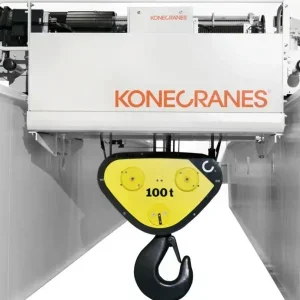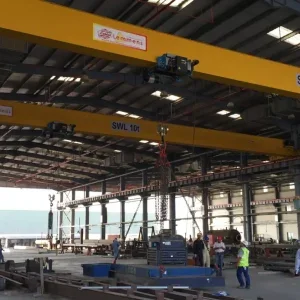This month I start to fill in the detail, starting with some of the most widely used lifting accessories, the slings.
Sling types
Sling types fall into three broad categories: chain, wire rope and textile. Textile slings include those made from webbing, fibre rope and endless roundslings. Within each category are a number of variants. General purpose slings of all types are covered by harmonised European Standards. These standards have a special status. If a product is made to a harmonised standard, it is deemed to comply with the legal requirements of the European Directives in so far as they are dealt with by the scope of the standard.

Modern industry is very conscious about risk and the legal duty to assess, control and, insofar as is possible, to eliminate or minimise it. The starting point is to identify the potential hazards. A hazard is something with the potential to cause harm and risk is a combination of the likelihood of it occurring and the severity of the consequences.
The European legal requirements for lifting accessories are in the Machinery Directive. Manufacturers are required to identify the hazards associated with their products and control the risks in a hierarchical manner, by design where possible, then by guarding and other measures down to and including instructions for use.
The same process is used to write the standards. To achieve harmonised standard status, the standard must specify all the requirements necessary to adequately control the risks. The standard must also include the methods of verifying that the requirements have been met. This approach means that it should not be possible for a product which is genuinely made to a harmonised standard to be unsafe when properly used.
Older national and international standards were often open to interpretation and not so watertight. Also there was a tendency by some manufacturers to equivocate and only claim that their product was generally in compliance with a standard, leaving the purchaser unsure of what that meant.

Therefore to ensure a good level of safety when purchasing slings, always specify the relevant harmonised standard number and require the supplier to state that they fully comply.
Sling configurations and terminal fittings
There are five basic configurations of sling: single-leg, two-leg, three-leg, four-leg and endless. The availability of each configuration depends upon the type of sling and will be explained in more detail later. Depending on the sling type, there is a variety of terminal fittings to choose from. As well as those for general applications, there are fittings which enable a sling to be tailored to specific loads. They include pipe hooks, bale hooks, foundry hooks, can hooks and case/carton grabs. Where appropriate, the use of such purpose-designed fittings is highly recommended.
Each type of sling has its own characteristics and the best choice of type and configuration will depend very much on the nature of the load.
Chain
Chain is a very durable and versatile option. It is flexible, and therefore able to wrap around the load. Packing is often required between the sling and the load to prevent chain links being bent over a corner of the load or the chain damaging the surface finish of the load. A shortening clutch or hook allows the leg length to be easily adjusted to the nearest link. Depending upon the grade, chain slings tolerate a wide range of operating temperature. The grade of chain is determined by the mean stress in the chain at the minimum breaking load. The higher the grade, the smaller and therefore lighter the chain for a given working load.
Currently the most popular is grade 8 to EN 818-4 which is manufactured from alloy steel. It is relatively difficult and expensive to assemble slings of this grade by welding so the vast majority are mechanically assembled using coupling components or fittings with a clevis and pin. Sling systems comprise chain and a variety of components in a range of sizes. From these, slings are assembled to specific customer requirements, usually by authorised distributers. Several manufacturers offer grade 10 chain and components which have some advantages, particularly a further saving in weight.
Although not widely used now, grade 4 slings to EN 818-5 are still available. These can be easily assembled by welding and are more suitable for some applications, particularly those involving high temperature or an acidic environment. Chain slings made from alloy steel, for example, grade 8 and above, are not suitable for use in acidic environments as this can cause hydrogen embrittlement.
Both grade 4 and 8 can be used in the temperature range from -40 degrees C to 200 degrees C without any reduction in working load. With a reduced working load, grade 4 can be used up to 475 degrees C and grade 8 can be used up to 400 degrees C.
The upper terminal of single and multi-leg chain slings is usually an oval link big enough to fit onto a crane hook of similar working load. For general purpose applications the lower terminal fittings are usually a hook with a safety latch. Also available are self-locking hooks which are opened by releasing a latch but close automatically under tension. Another option are C hooks. These do not have a safety latch but have a turned in tip which reduces the likelihood of detachment when not under load. They also have a beak or projection at the top of the hook which, in combination with the turned in tip, prevents the hook from snagging when being pulled under or through a load. These features and their general robustness make them popular in many applications, particularly on construction sites.
Most sling system manufacturers also offer terminal fittings for particular applications. Pipe hooks engage over the end of a pipe or hollow box. Foundry hooks are shaped to fit sand box trunnions. Bale hooks are pointed so as to dig into a bale. Can hooks are shaped to engage with the lip of a drum lying on its side.
Wire rope
Wire rope offers an economical alternative to chain for many applications and also has advantages of its own. It is easier to feed under a load as it can often be pushed through. Slings made from galvanised rope and thimbles are more tolerant of marine or similar environments.
Wire rope slings can tolerate temperatures down to -40°C without de-rating but performance may be affected depending on the effectiveness of the lubricant. The upper temperature limit varies according to several factors including the material the ferrule is made from. Generally advice should always be sought for applications above 100°C and the upper limit is 200°C.
Wire rope slings are at their most advantageous when the legs are in a straight pull such as when suspending a spreader beam. If wrapped around a load, they inevitably become permanently set to the shape of the load unless a large radius can be maintained. Packing may be required to provide an adequate radius and to protect the surface of the load from the wire rope.
The length of a wire rope sling cannot be adjusted by the user. However, a two-leg arrangement, utilising a continuous length of wire rope and a special top fitting, does allow one leg to be shortened as the other is lengthened. This is very useful if adjustment is required to match the centre of gravity of the load.
The harmonised European Standard for wire rope slings is EN 13414-1. To make a sling, the wire rope is terminated with an eye. At one time these were always hand spliced, a relatively slow process which also produces a long tapered termination. Now virtually all eyes are ferrule secured. The ferrule is squeezed onto the rope by shaped dies in a hydraulic press causing it to grip the rope very firmly.
The simplest eye is a turned back loop secured by the ferrule. A Flemish eye, where the rope strands are undone then re-laid to form the eye with half the strands going round the eye in one direction and half in the other and the tails secured within the ferrule, is more efficient but also more complex to make.
Many wire rope slings are single-leg with a large soft eye at each end. One or more, possibly of different lengths and working loads, can be used in combination with shackles to make a temporary assembly for a particular job. Permanently assembled multi-leg wire rope slings usually have an upper terminal link and hooks or other lower terminal fittings similar to a chain sling. When assembled with links and fittings, the wire rope will be terminated with a small hard eye. The hard eye includes a thimble which prevents wear on the rope and maintains the shape of the eye to ensure that the terminal fittings can articulate properly.
Next month I will look in detail at the various types of textile sling, the way that slings are rated, and the assumptions made in the standard ratings.
About the author
Derrick Bailes is technical consultant (formerly chief executive) for the Lifting Equipment Engineers Association, 3 Osprey Court, Kingfisher Way, Hinchingbrooke Business Park, Huntingdon, PE29 6FN, tel: +44 (0)1480 432 801, fax: +44 (0)1480 436 314, email: info@leea.co.uk






